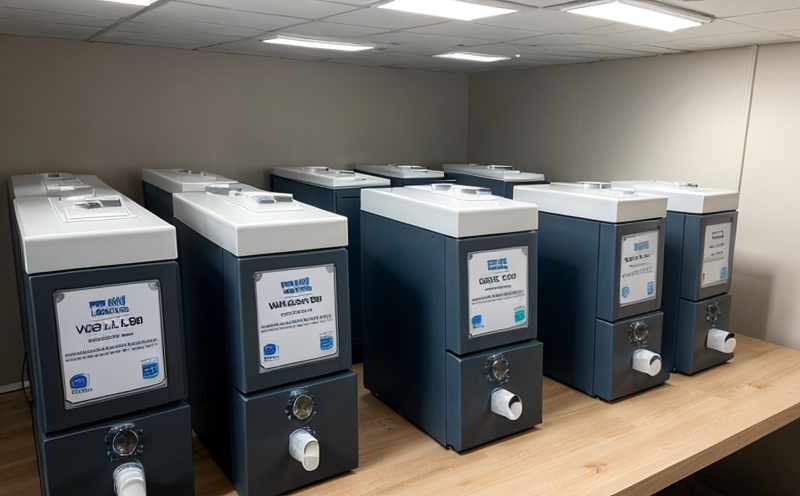AATCC 189 Screening of volatile compounds in fabrics
The AATCC (American Association of Textile Chemists and Colorists) Method 189 is a widely recognized standard for the screening of volatile organic compounds (VOCs) including formaldehyde, in textiles. This method is particularly relevant for ensuring textile products meet environmental and health safety standards by minimizing exposure to harmful VOCs.
The testing procedure involves exposing fabric specimens to controlled conditions that simulate real-world usage scenarios, such as storage or wearing. The specimen is then analyzed using gas chromatography-mass spectrometry (GC-MS) techniques to identify and quantify volatile compounds released from the fabric surface. This ensures that products comply with regulations set by bodies like the European Union’s REACH Directive.
The process begins by selecting appropriate specimens, typically cut into standard sizes, depending on the type of product being tested. Pre-treatment steps may include washing or conditioning to simulate actual use conditions. Post-treatment, the samples are placed in chambers where they undergo exposure to controlled temperature and humidity levels over a specified duration.
The identification and quantification of VOCs is achieved through rigorous analytical techniques that ensure accuracy and precision. The results provide critical insights into potential health impacts and help manufacturers make informed decisions regarding material selection and processing methods. This testing method not only aids in compliance with regulatory requirements but also supports brands' sustainability efforts by ensuring their products are safe for consumers.
Understanding the context of this standard, it is essential to note that AATCC Method 189 focuses on a specific subset of VOCs known as semi-volatile organic compounds (SVOCs), which have intermediate volatility and mobility. These SVOCs include formaldehyde among others, making it crucial for industries handling textiles, particularly those intended for prolonged human contact.
The test results are typically reported in parts per million (ppm) or micrograms per cubic meter (µg/m³). These measurements help stakeholders understand the levels of potentially harmful compounds present in textile products. Compliance with this standard ensures that fabrics meet stringent environmental and health safety standards, thereby protecting end-users from potential risks associated with exposure to high levels of VOCs.
In summary, AATCC 189 is a vital tool for quality assurance teams looking to ensure their products are safe and compliant with international regulations. By adhering to this method, companies can demonstrate their commitment to sustainability and consumer safety while maintaining competitive advantage in the market.
Eurolab Advantages
At Eurolab, our expertise in providing comprehensive textile testing services is unparalleled. Our team of highly qualified professionals ensures that every aspect of AATCC 189 is meticulously followed, delivering accurate and reliable results.
- Accurate Results: Utilizing cutting-edge GC-MS technology, we provide precise measurements of VOCs present in textiles.
- Rigorous Quality Assurance: All our processes are conducted under strict quality control measures to ensure reliability.
- Comprehensive Reporting: Detailed reports that not only include numerical data but also interpretive insights into the significance and potential impact of findings.
- Industry Knowledge: Our staff includes experts who stay updated with the latest developments in textile chemistry and safety standards.
We pride ourselves on offering a seamless testing process from sample preparation to final report delivery. With Eurolab, you can trust that your textiles are being evaluated against stringent criteria ensuring both compliance and quality.
Environmental and Sustainability Contributions
Evaluating textile products for volatile compounds like formaldehyde through AATCC 189 contributes significantly to environmental sustainability. By identifying and minimizing the release of harmful VOCs, manufacturers can reduce their carbon footprint and improve overall product quality.
The use of sustainable materials and manufacturing processes is increasingly important in today’s market. Testing for formaldehyde helps ensure these efforts are effective by providing data on residual levels post-production. This information allows companies to make adjustments as needed, promoting cleaner production methods and reducing adverse effects on the environment.
| Environmental Impact | Description |
|---|---|
| Emission Reductions | Lowering the amount of VOCs released into the atmosphere reduces air pollution and associated health risks. |
| Sustainable Practices | Promoting sustainable practices by identifying areas for improvement in production processes. |
| Consumer Safety | Ensuring products are safe for consumers, thereby enhancing public trust and support for eco-friendly initiatives. |
By adhering to standards like AATCC 189, businesses can contribute positively towards sustainable development goals. This includes reducing waste generation, conserving resources, and fostering innovation in green technologies.
Use Cases and Application Examples
- Clothing Manufacturers: Ensuring compliance with REACH Directive for formaldehyde content in garments.
- Furniture Makers: Verifying that upholstery fabrics meet VOC emission limits set by relevant regulations.
- Home Textile Producers: Guaranteeing the safety of bed linens and other household items exposed to human skin.
- Footwear Companies: Checking for formaldehyde in leather accessories and shoe uppers.
In addition to these, Eurolab also serves educational institutions conducting research on textile chemistry and environmental impacts. Our services provide valuable data that can be used to develop new products or improve existing ones based on rigorous scientific evaluation.





